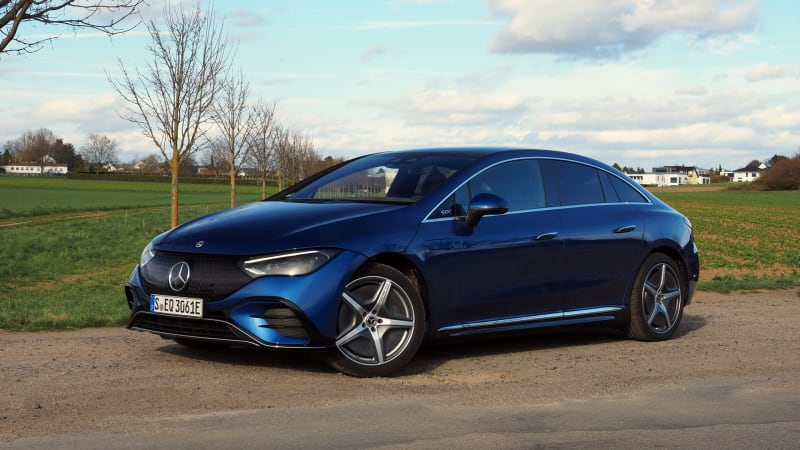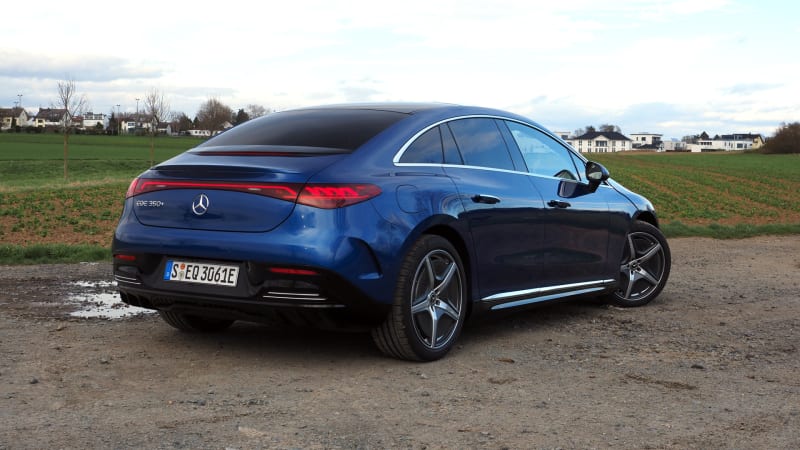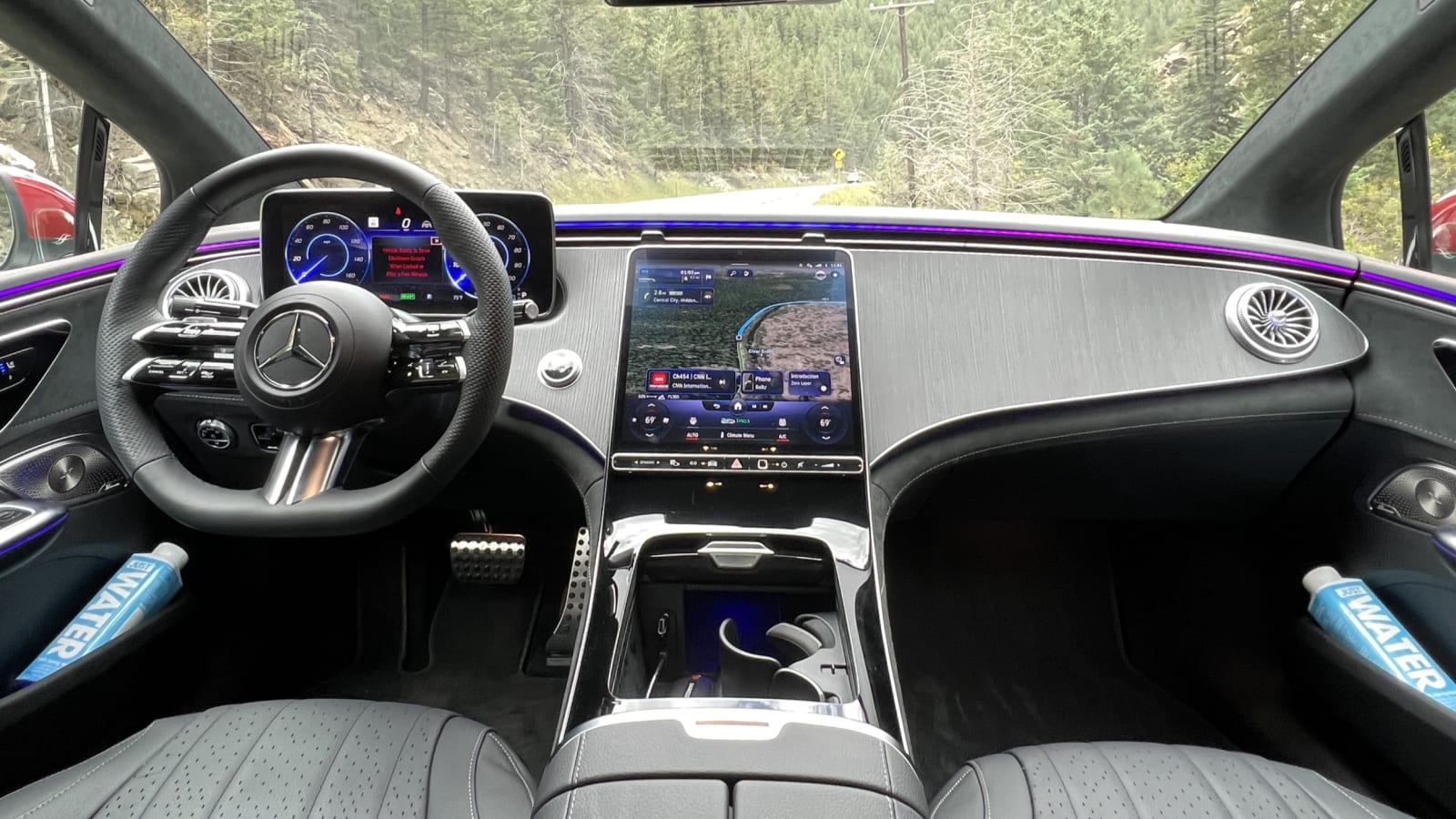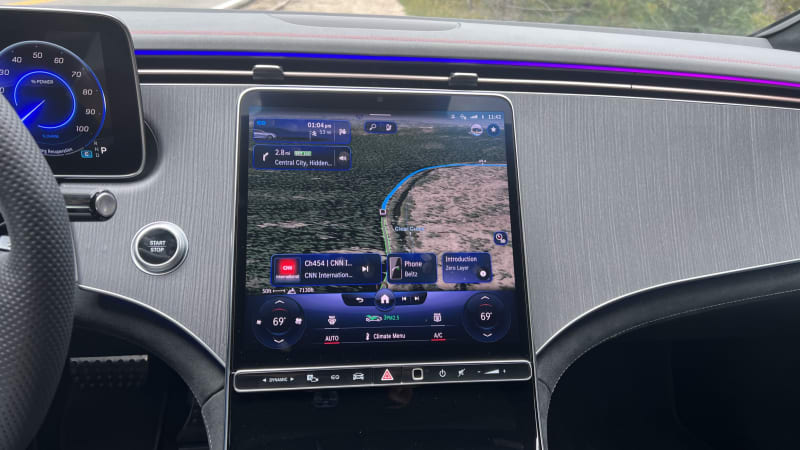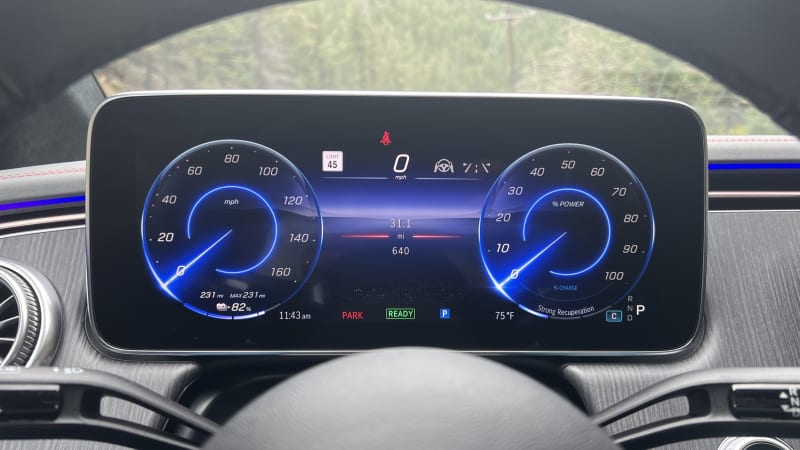DETROIT — What comes out the other side when Mercedes-Benz chucks a well-established midsize luxury sedan nameplate into its magical EV converter? Take one look at the 2023 EQE sedan and you know right away that this isn’t merely a gasoline car with an electric powertrain in place of its old grease-covered parts. This is a clean sheet, free of the stains of dirty diesel and CO2 emissions, and in a way, a complete reimagining of the midsize Mercedes sedan. Whether that’s for better or worse is entirely up to you.
If you’re familiar with Mercedes model hierarchies, you’ll recognize the 350 designation for a base powertrain in the company’s E-segment (midsize executive car) offerings. Our tester’s 4Matic configuration actually bumps it up the ranks a tad, as AWD in an EV means you’re getting a second motor. Like the base, rear-wheel-drive EQE 350+, this one comes with a 90.6 kilowatt-hour battery pack, however, total estimated range is down to 260 miles versus the single-motor’s 305 miles. Mercedes says the EQE can be fully charged in 9.5 hours on a Level 2 wall unit or from 10-80% in 32 minutes on a DC fast charger.
We’re still years away from EV power delivery being the norm rather than the exception, so contextualizing the EQE’s performance is tricky. Its total combined output is 288 horsepower (215 kW). That’s about what you’d expect from a run-of-the-mill, turbocharged four-cylinder engine in 2023. Those motors are tasked with moving 5,400 pounds of Mercedes plus whatever you put inside of it, which is not what you’d expect from a run-of-the-mill sedan. In fact, that’s pretty much the exact same weight as the much larger, gasoline-powered GLS 450, which packs a 362-hp biturbo V6.
An EQE 350 driven during our EQE first drive
Now here’s the kicker: despite the bigger SUV’s 20-plus-percent power advantage, it’s essentially no quicker to 60 than the EQE. Mercedes-Benz says the EQE 350+ can hit 60 in 6.0 seconds while the GLS can do it in 5.9. The reason? Torque. The dual-motor EQE has 564 pound-feet, whereas the GLS has 369. Not only that, but the torque produced by electric motors is largely available the moment they start spinning, meaning they’re typically much quicker than gasoline engines of equivalent horsepower. From a dead stop, the EQE can go full-tilt instantly. By comparison, gas-powered cars leaving the same stoplight seem like they’re working a lot harder just trying to keep up — because they are.
The electronic acceleration noises Mercedes programmed help drown out the outside world and contribute some drama to the event, but even that can be turned off. Frankly, this is the sort of serene shove in the back that luxury cars have always aimed for but usually fall short of due to their internal-combustion limitations. True luxury cars don’t have big engines because they’re meant to be hustled everywhere; they have big engines so they can don’t have to work nearly as hard to go just as fast as the rest of us. And at that, the EQE excels.
Dynamically, the script gets flipped — to an extent. 5,400 pounds is a lot of mass to throw around, and even if the electric motors are eager to get it moving (they are “permanently excited,” after all), you still have to turn and stop. Mercedes offers several levels of electric regeneration activated by wheel-mounted paddles that in a different car would control a transmission. There is no one-pedal drive mode, but the max regen setting will drag you down to a crawl before requiring you to take over with the brake pedal. As with the EQS but unlike the EQB, that brake pedal moves by itself to emulate where it would be if you had been braking the whole time. I didn’t have an issue with it, but others have, finding it difficult to stop the car smoothly. Either way, we feel it’s a strict downgrade from both conventional hydraulic brakes and the one-pedal arrangement offered by many EV builders, including BMW.
Corners are a bit more of a mixed bag. The sedan’s already-advantageous center of gravity is augmented by the placement of the battery pack low in the chassis, so body control remains solid despite the hefty curb weight and plush ride. It’s frankly impressive how determinedly the EQE will nose into a corner when asked. At least some credit has to go to the rear-axle steering system (see video at the bottom of this page), but even with this extra mechanical assistance, the EQE lacks the sharp reflexes and feedback of, say, the smaller and somewhat lighter BMW i4.
Despite the entry-level powertrain, our EQE tester came quite impressively equipped. The Pinnacle package is a box-checker’s dream. It includes the full MBUX infotainment package with augmented reality navigation features. Imagine having somebody actually point to your next turn, rather than just expecting you to know that West 223rd Street is that alleyway hidden between the dumpster and cardboard condominiums. It’s admittedly more impressive with the augmented reality head-up display, which beams those arrows onto the windshield rather than a video feed, but it’s still useful even if you have to glance at the infotainment screen for clarification. It sounds like a gimmick, but many great features start out that way, and this one’s a keeper.
That’s on top of the excellent Burmester sound system (also included with the mid-tier Exclusive package), niceties like ambient lighting and surround-view camera, heated seats and a laundry list of other features that we’ve come to expect from modern luxury cars. A Pinnacle model starts at $81,650. That’s a lot when you consider the basic-spec powertrain, but remember, $15,000 of that is just options.
The downside to all of those options is that there’s pretty much only one place to access them: the MBUX infotainment system. Redundant buttons have been disappearing rapidly from Mercedes interiors. Admittedly, the result looks rather sleek, leapfrogging the cheapness-disguised-as-minimalism that we see in some big-ticket EVs. But aesthetic gains come at functional losses, and this is no exception.
As we’ve experienced elsewhere in the lineup, Benz’s user experience salvation comes not from its touchscreens, but from its voice command system. MBUX has its faults, but understanding the spoken word is not one of them. Nine times out of 10, if you can’t find the thing you need, simply saying “Hey, Mercedes, turn on the thingamabob” will get the job done. For that 10th time? Oof. Hope you like menus.
While poking and prodding at a giant tablet is a decidedly compromised way to go about interacting with a car, Mercedes deserves credit for at least making it work fairly well even we don’t love the way it works. Unlike older touchscreens, which crumble in the face of something as insidious as a set of gloves, MBUX’s touchpoints accept inputs from leather-wrapped digits without any muss or fuss. Whether it was the capacitive controls on the wheel or the screen itself, interacting was never an issue. I didn’t have any heavy-duty snow gloves on hand (yeah, yeah) to test, but I’d wager the non-organic material and thicker insulation would render the interface unusable. Still, it’s better than nothing.
The EQE’s jelly-bean look is slick and undoubtedly efficient, but comes off rather anonymous and forgettable apart from some of its least charming elements (that rear bumper, yikes). The bubbly Chrysler “cloud cars” of the 1990s did cab-forward better, quite frankly. When the EQE’s time has come and gone, I suspect its shape won’t be missed.
Normally, I don’t really get into design when road-testing a car, but in this case I believe it’s warranted simply because it may be the single biggest turn-off to a good chunk of the EQE’s intended audience. A sleek, futuristic shape may be attractive to those who think EVs must take such a form, but for the buyer who wants a Mercedes first and an electric vehicle second (or maybe even third, fourth or fifth; we’re still in the early days of EV conquests), I’m struggling to see the appeal. Perhaps a nontrivial number of those potential buyers care only about the badge and I’m overestimating the raw appeal of traditional Mercedes design. Then again, maybe not.
Fortunately for the EQE, it’s merely one of many new electric models Mercedes is churning out. That means it’s not solely responsible for forging the company’s EV reputation. That’s probably a good thing in some respects, as the EQE is not a one-size-fits-all proposition. As off-putting as I find the styling, there’s a lot to like here, especially when you consider that the 350 is just the EQE’s starting point. It only gets better from here, and “here” is already pretty good.
Related Video:


